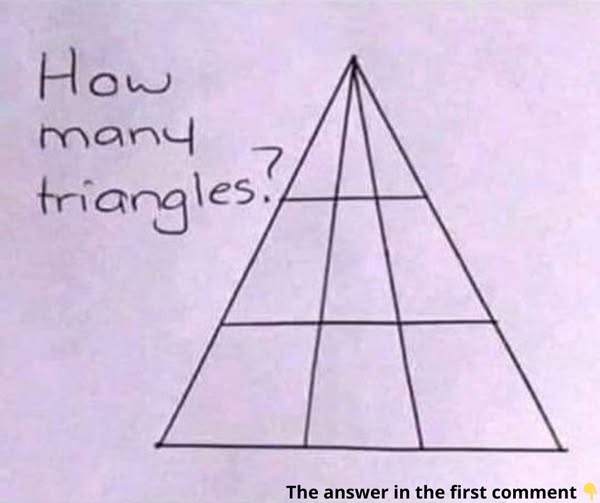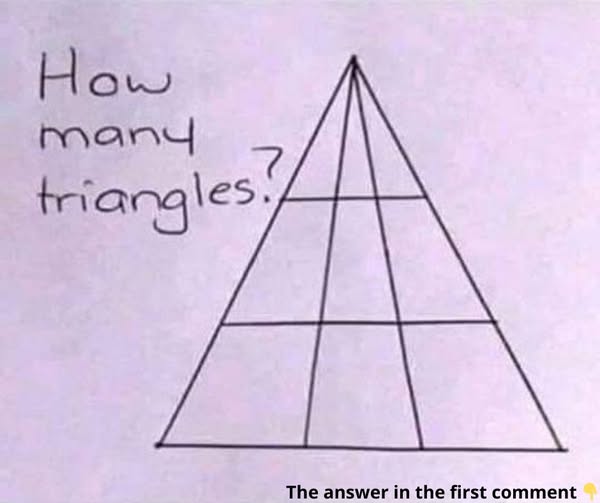How many triangles do you see here?
At first glance, the puzzle seems straightforward: “How many triangles do you see?” It’s a question that challenges not only your visual perception but also your problem-solving skills. But as you begin counting, you quickly realize it’s more complicated than it seems. This seemingly simple brain teaser has stumped many, leading to a range of different answers from those attempting to solve it.

Even celebrities like Bollywood stars Sonam Kapoor, Aditi Rao Hydari, and Diana Penty were intrigued by the puzzle after fashion magazine editor Jitesh Pillai shared it on social media. It’s a great example of how something so simple can capture the imagination of many. But how do you solve this tricky triangle puzzle, and what is the correct answer?
At first, you might think counting triangles is easy: just count the shapes you see and you’re done, right? But this puzzle isn’t that simple. The trick lies in recognizing all the triangles, both large and small, and ensuring that you don’t double-count or miss any hidden within larger triangles. The overlapping nature of these triangles is where most people get tripped up.
Many people give different answers because they only count the obvious triangles or they get lost in the complexity of larger and smaller shapes interlocking with one another. But if you approach the puzzle with a systematic method, the correct number becomes clear.
The key to solving this puzzle lies in breaking down the figure into smaller parts. Instead of simply trying to count by sight, it helps to divide the puzzle into sections and count each part individually before adding them together.
Here’s how to approach it:
- Start with the smallest triangles: These are the most obvious ones and are usually at the base of the puzzle. Count each individual small triangle you see.
- Move on to medium-sized triangles: These triangles often form when two or more smaller triangles combine. Be careful to count each new shape without counting the same area twice.
- Don’t forget the large triangles: The entire puzzle might form one or more large triangles. These are easy to overlook but are critical to the correct answer.
- Watch out for overlapping triangles: Some triangles are formed by overlapping smaller triangles. These hidden triangles can be the hardest to spot but are essential for getting the right total.
The Power of Mathematical Reasoning
If counting by sight is too overwhelming, there’s also a clever mathematical method that can help you tally the triangles quickly and accurately. This involves breaking the figure into distinct units and using a formula to calculate the total number of triangles.
In this particular puzzle, the answer is revealed to be 18 triangles. At first, that number might seem surprising, especially if your first count came up short. But once you break down the puzzle systematically, you’ll see how all 18 triangles come together.
Here’s a breakdown of how to find the total number:
- 6 smallest triangles: These are the basic building blocks.
- 6 medium triangles: These are formed by combining two smaller triangles.
- 4 larger triangles: These are created by combining smaller and medium triangles.
- 2 largest triangles: These are formed by combining nearly all the smaller parts into one big triangle.
This method shows the importance of being methodical and breaking the problem down into smaller, manageable pieces. Instead of relying on quick guesses or rough estimates, the mathematical approach ensures that you reach the correct answer.
The “How many triangles?” puzzle is a perfect example of how a seemingly simple question can challenge even the sharpest minds. Whether you’re casually counting by sight or using a mathematical approach, the puzzle requires careful attention to detail, strategic thinking, and a bit of patience.
Ultimately, puzzles like this serve as great reminders of how much fun problem-solving can be. They teach us to slow down, think critically, and look at problems from all angles. And when we finally arrive at the answer—whether it’s 18 triangles or something else entirely—there’s nothing quite like the satisfaction of having cracked the code.





